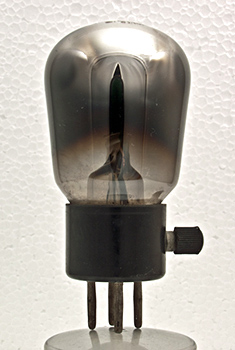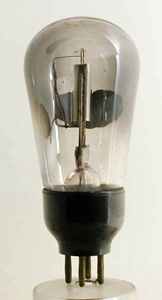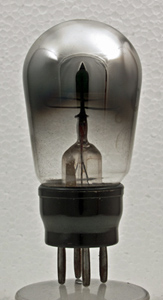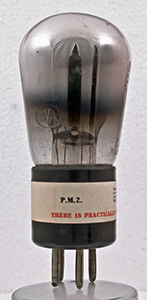|
Why are set builders so chary about using the pentode? The valve is a good one, but somehow it seems to have 'hung fire', and has not met with the same public acclaim as the screened-grid valve. Why this is so is clearly explained in this informative article.

The Mullard PM24 - the UK's first pentode.
The pentode power valve has now been on the market for some considerable time. Although it is used in many three-valve commercial receivers, among home constructors it has not attained to anything like the same popularity as the screened-grid valve.
The reason for this is not far to seek, for it may be traced to a few misstatements or, rather, incomplete statements, made when the valve was first brought out. It was said that it gave an undistorted power output with 150 Volts HT, equal to that given by an LS5A with 300 Volts HT; also that it gave an amplification so great that one low-frequency stage could be omitted without loss of signal strength.
Conditions for Maximum Power
The valve is quite capable of giving either this high output or this great amplification, but not at the same time. The conditions for maximum power output are quite different from those for high amplification.
The operating conditions of the pentode are very different from those of an ordinary three electrode power valve. With the latter the load, due to the loud speaker, must have an impedance equal to twice the internal valve resistance for maximum power output. This figure is not very critical so long as the load impedance is higher than the valve resistance; this is very useful, as the impedance of the average loud speaker varies considerably at different frequencies. At low frequencies it may be 1,000 Ω, while at high frequencies it may be as high as 10,000 Ω.
What is usually done is to choose a valve about the same impedance as the loud speaker at a fairly low frequency, or to use an output transformer to adjust the speaker impedance to that of the valve. For a loud speaker having an impedance similar to that given above, a valve between 1,000 and 2,000 Ω would give the best results. The lower the valve resistance the better will the bass notes be reproduced, but if it is too low there will be a loss of high notes.
Why Speakers Sound Shrill
Now with the pentode it is entirely different, the maximum undistorted power output is obtained when the loud-speaker impedance is between 6,000-10,000 Ω - that is, about one-sixth of the valve resistance. Not only that, it is fairly critical, for the speaker impedance is lower than the valve resistance. Taking the speaker impedances mentioned above, at high frequencies the maximum output will be obtained, but at low frequencies, where the speaker impedance is low, the output will be very small - somewhere about one-tenth of that at high frequencies. That is what makes an ordinary loud speaker sound so shrill when used with a pentode. The bass notes are not reproduced properly.
On the other hand, if an attempt is made to adjust the speaker impedance to the valve with an output transformer, difficulties again arise. The tone will be correct when the transformer has the proper ratio, the bass notes will be there, and they will be reproduced the same as with an ordinary power valve. But the power output will have fallen considerably, it will now be more or less, the same at all frequencies, but it will not be more than that given by an ordinary valve of about 5,000 Ω resistance.
The amplification will be much greater when a transformer is used, but that is not much use if the power output is small, for even today most sets really want a bigger output valve.
With the Moving Coil
What, therefore, is wanted in order to get a large power output with proper reproduction of the bass. Since the only reason for the loss of bass with an ordinary loud speaker is the variation of impedance, what is required is obviously a loud speaker with an impedance constant at all frequencies over the audible range. Given this, not only would the tone be correct, but the power output would be large. It would not matter what the actual value of the impedance was, so long as it was constant, for it could be adjusted with a transformer to suit the valve.
Unfortunately, no loud speaker has at constant impedance, but the moving-coil type has the most nearly constant; and, as a rule, one of this type is perfectly satisfactory with a pentode. The power output is high, being comparable with that of an LS5A on 300 Volts HT. The amplification. however, is on the low side for a pentode, although it is considerably higher than that given by an ordinary three-electrode power valve.
Same as LS5A

The LS5A.
It will be seen, therefore, that those who have stated that the pentode will give the same output as an LS5A are correct, provided that a moving-coil loud speaker is used, but they are only correct under that condition.
To sum up, if a moving-coil loud speaker is used, with its impedance adjusted by a transformer to be between 4,000-10,000 Ω, a pentode on 150 Volts HT will give at power output equal to that of an LS5A on 300 Volts HT.
If a reed-drive loud speaker is used, with a step-down output transformer to adjust its impedance to be about equal to that of the valve at a low frequency, the undistorted power output will only be about the same as that given by a 5,000 Ω valve, such as the DEP2l5 or the PM2.
 
The DEP215 and PM2.
|